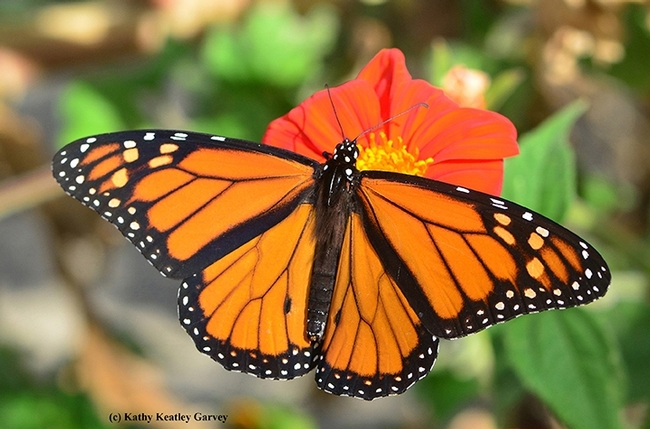- Author: Kathy Keatley Garvey
Newly published UC Davis research analyzing modern-day and museum collections of monarch butterflies over a 200-year period indicates that the loss of migration and range expansion leads to smaller and shorter wings.
The research, “Two Centuries of Monarch Butterfly Collections Reveal Contrasting Effects of Range Expansion and Migration Loss on Wing Traits,” appears this week in the Proceedings of the National Academy of Sciences.
“We measured the wings of 6,000 museum specimens of monarch butterflies collected from 1856 to the present, as well as contemporary wild-caught monarchs from around the world,” said lead author Micah Freedman, a former UC Davis doctoral candidate in population biology and now a postdoctoral fellow at the University of Chicago.
“The major implications of the research,” Freedman said, “are that it shows (1) loss of migration can affect the evolution of monarch butterflies over contemporary time scales--dozens to hundreds of years; and (2) monarchs with large forewings are better-suited for long distance movement, and this likely contributed to their global expansion over the past 200 years.”
Co-Authors of PNAS Paper
Freedman works closely with noted migratory animal authority and co-author Hugh Dingle, emeritus professor, UC Davis Department of Entomology and Nematology, who received a 2014 UC Davis Edward A. Dickson Professorship Award to research “Monarchs in the Pacific: Is Contemporary Evolution Occurring on Isolated Islands?” They co-authored the research with Sharon Strauss, professor and Santiago Ramirez, associate professor, Center for Population Biology and the Department of Evolution and Ecology.
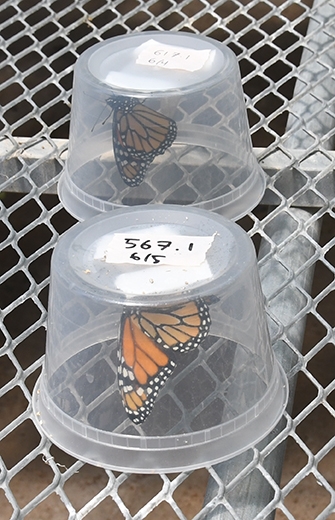
Their research documents how migration-associated traits may be favored during range expansion but disfavored when species cease seasonal migration. “Furthermore, it highlights the value of museum collections by combining historical specimens with experimental rearing to demonstrate contemporary evolution of migration-associated traits in natural monarch populations,” Freedman said.
Said Dingle: “At a time when museum collections are under pressure from a scarcity of funding, the results also show just how valuable such collections can be to evolutionary research and to the understanding of ongoing biological processes in the face of anthropogenic change.”
In their abstract, they pointed out that “migratory animals exhibit traits that allow them to exploit seasonally variable habitats. In environments where migration is no longer beneficial, such as oceanic islands, migration-association traits may be selected against or be under relaxed selection.”
“Monarch butterflies are best known for their continent-scale migration in North America but have repeatedly become established as non-migrants in the tropical Americas and on Atlantic and Pacific Islands,” they wrote. “These replicated non-migratory populations provide natural laboratories for understanding the rate of evolution of migration-associated traits.”
What They Determined
They determined (1) how wing morphology varies across the monarch's global range, (2) whether initial long-distance founders were particularly suited for migration and (3) whether recently-established non-migrants show evidence for contemporary phenotypic evolution.
Under controlled conditions in a UC Davis lab, they also reared more than 1000 monarchs from six populations around the world and measured migration-associated traits.
“Historical specimens show that initial founders are (1) well-suited for long-distance movement and (2) loss of seasonal migration is associated with reductions in forewing size and elongation,” they related. “Monarch butterflies raised in a common garden from four derived non-migratory populations exhibit genetically based reductions in forewing size, consistent with a previous study.”
Dingle said the findings “provide a compelling example of how migration-associated traits may be favored during the early stages of range expansion, and also the rate of reductions in those same traits upon loss of migration.”
Statistics show that the population of monarch butterflies in the United States has declined by 90 percent over the past 20 years.
Undergoing Contemporary Evolution
The monarch butterflies established just 200 years ago in remote Pacific Islands are undergoing contemporary evolution through differences in their wing span and other changes, Dingle said. He and Freedman studied monarchs in the Pacific Islands for a week in 2016 in a project funded by Dingle's UC Davis emeritus faculty grant, the Edward A. Dickson Professorship Award. The research involved measuring the wingspans of Guam monarchs to determine whether there has been an evolutionary decrease in size or shape due to their migration-free lifestyle on the island. They also measured the wings of monarchs in the University of Guam's museum collection.
An analysis of a monarch population in Hawaii shows that resident monarchs have shorter, broader wings than the long-distance migrants, Dingle noted. The Hawaii butterfly wings were shorter than the eastern U.S. long-distance migrants, but “not so short-winged as the residents in the Caribbean or Costa Rica, which have been present in those locations for eons, rather than the 200 years for Hawaii.”
Dingle, author of two editions of Migration: The Biology of Life on the Move (Oxford University Press), a fellow of the American Association for the Advancement of Science and a past president of the Animal Behavior Society, said previous studies by various authors revealed that migrant and long-resident monarchs exhibit different wing shapes. "Thus, it was desirable to examine populations with only short residency to see if the same phenomenon was evident.”
Dingle, who served as a UC Davis entomology professor from 1982 to 2002, achieving emeritus status in 2003, has engaged in research throughout the world, including the UK, Kenya, Thailand, Panama, Germany and Australia. National Geographic featured Dingle in its cover story on “Great Migrations” in November 2010. LiveScience interviewed him for its November 2010 piece on“Why Do Animals Migrate?”
The Bohart Museum of Entomology at UC Davis was among the 22 global museum collections studied. The research also included private collections and online databases. Freedman and assistant Christopher Jason reared some of the butterflies included in the PNAS paper in a UC Davis greenhouse.
The project drew funding from the National Science Foundation (NSF) Graduate Research Fellowship Program, the NSF East Asia and Pacific Summer Institute Program, the UC Davis Center for Population Biology, and the National Geographic Society to Freedman, as well as the Dickson Emeritus Professor Award to Dingle, a California Agricultural Experiment Station grant to Strauss, and a David and Lucille Packard Fellowship to Ramirez.
The abstract:
“Migratory animals exhibit traits that allow them to exploit seasonally variable habitats. In environments where migration is no longer beneficial, such as oceanic islands, migration-association traits may be selected against or be under relaxed selection. Monarch butterflies are best known for their continent-scale migration in North America but have repeatedly become established as non-migrants in the tropical Americas and on Atlantic and Pacific Islands. These replicated non-migratory populations provide natural laboratories for understanding the rate of evolution of migration-associated traits. We measured more than 6,000 museum specimens of monarch butterflies collected from 1856 to the present, as well as contemporary wild-caught monarchs from around the world. We determined (1) how wing morphology varies across the monarch's global range, (2) whether initial long-distance founders were particularly suited for migration and (3) whether recently-established non-migrants show evidence for contemporary phenotypic evolution. We further reared more than 1,000 monarchs from six populations around the world under controlled conditions and measured migration-associated traits. Historical specimens show that (1) initial founders are well-suited for long-distance movement and (2) loss of seasonal migration is associated with reductions in forewing size and elongation. Monarch butterflies raised in a common garden from four derived non-migratory populations exhibit genetically-based reductions in forewing size, consistent with a previous study. Our findings provide a compelling example of how migration-associated traits may be favored during the early stages of range expansion, and also the rate of reductions in those same traits upon loss of migration.”
As a postdoctoral fellow at the University of Chicago, Freedman said he is "currently using breeding experiments and DNA sequencing trying to figure out which genes affect migratory traits and behaviors in monarchs. This includes wing traits (shapes and size) discussed in the PNAS paper.”
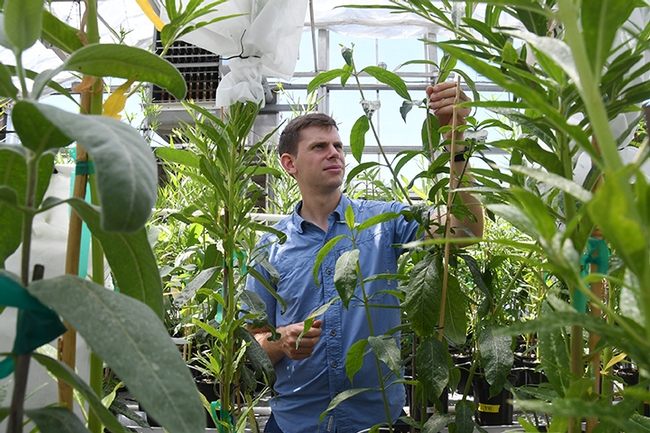
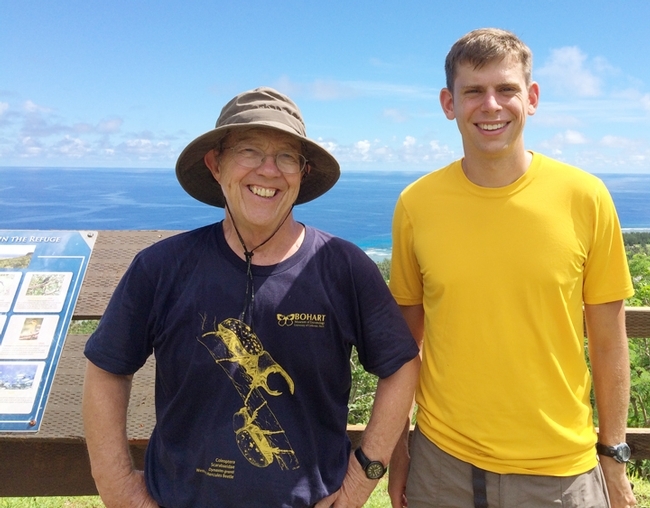
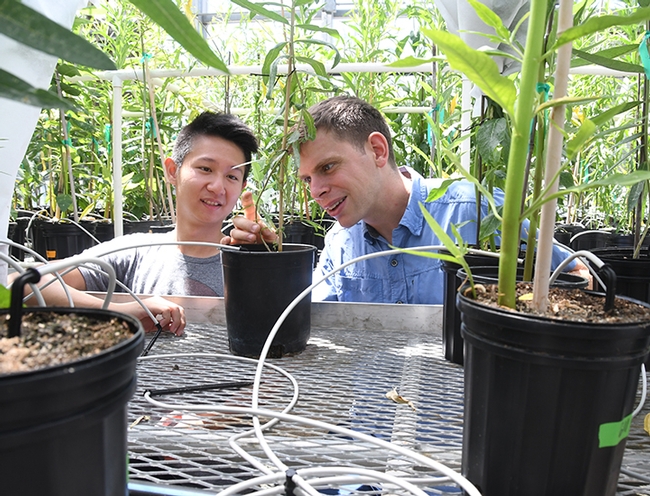
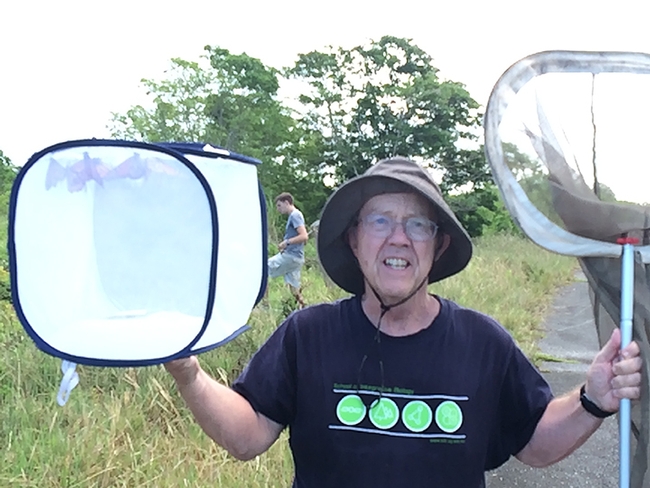
- Author: Kathy Keatley Garvey

The two emeriti professors from the UC Davis Department of Entomology and Nematology were among five honored at the event. Also honored were Dickson recipients/emeriti professor Daniel Anderson of the Department of Land, Air and Water Resources; Martha Macri of the Department of Linguistics; and Peter Schiffman, Department of Geology. (See web page.)
UC Davis Chancellor Linda P. B. Katehi, Provost Executive Vice Chancellor Ralph Hexter, and emcee Bill Rains, past president of the UC Davis Emeriti Association, praised them for their work.
Robbin Thorp
Thorp was singled out for the distinguished emeritus award for his outstanding scholarly work and service accomplished since his retirement in 1994. "Dr. Robbin Thorp should be the first scientist to be cloned," said emcee Rains, quoting James Cane of the USDA-ARS Pollinating Insect Research Unit, Utah State University, Logan.
Thorp, who joined the UC Davis entomology faculty in 1964 and achieved emeritus status in 1994, is a state, national and global authority on pollination ecology, ecology and systematics of honey bees, bumble bees, vernal pool bees, conservation of bees, contribution of native bees to crop pollination, and bees of urban gardens and agricultural landscapes.
Since his retirement, he has compiled an exemplary record for his research, teaching, publications, presentations, and advisement services, sharing his expertise with local, statewide, national and international audiences. In his retirement, he has published 68 papers and is the first author on 15 publications. He received several prestigious awards: the 2013 outstanding team award, with several colleagues, from the Pacific Branch of the Entomological Society of America, and the 2010-2011 Edward A. Dickson Emeriti Professorship, UC Davis. Thorp is the North American regional co-chair for the International Union for Conservation of Nature (IUCN) Bumblebee Specialist group. He is a member of 10 professional societies, including the International Society of Hymenopterists.
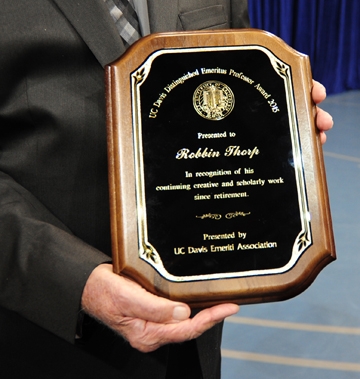
Thorp maintains his office and research headquarters in the Harry H. Laidlaw Jr. Honey Bee Research Facility on the UC Davis campus. Among his latest publications: he co-authored two books published in 2014: Bumble Bees of North America: An Identification Guide (Princeton University Press) and California Bees and Blooms: A Guide for Gardeners and Naturalists (Heyday). Of the 20,000 bee species identified worldwide, some 4000 are found in the United States, and 1600 in California.
Thorp spends much of his time in the Bohart Museum of Entomology, which houses collections critical to his bee identification work. He identifies species and regularly volunteers at the open houses and other event.
Thorp is an integral part of The Bee Course, an annual 10-day workshop sponsored by the American Museum of Natural History and held at the Southwestern Field Station near Portal, Ariz. He has taught there since 2002 (the instructors are all volunteers), and even though he is 81 years young, he plans to continue teaching there. (See more on the departmental web page.)
Hugh Dingle
Hugh Dingle. an international authority on animal migration, received a Dickson award to help fund his research on monarch butterflies, “Monarchs in the Pacific: Is Contemporary Evolution Occurring on Isolated Islands?” Monarch butterflies established just 200 years ago in remote Pacific islands are undergoing contemporary evolution through differences in their wing span and other changes, he believes.
Dingle, author of two editions of “Migration: The Biology of Life on the Move,” said his previous studies reveal that migrant and resident monarchs exhibit different wing shapes. He will be working with community ecologist Louie Yang and molecular geneticist Joanna Chiu, assistant professors in the UC Davis Department of Entomology and Nematology, to examine the ecology and physiology of monarch butterflies (Danaus plexippus) in three islands where contemporary evolution might be expected. The islands are Oahu (Hawaii), Guam (Marianas) and Weno (Chuuk or Truk).
“This is the necessary first step in a long-term analysis of the evolutionary ecology and physiology of monarch butterflies on remote Pacific islands,” said Dingle, a fellow of the American Association for the Advancement of Science and the Animal Behavior Society.
Dingle said the monarch, widely distributed “for eons” in the New World, is fairly new to the Pacific islands and to Australia. “In addition to North America, the monarch occurs as a resident throughout the Caribbean and Central and northern South America—and probably as a migrant farther south. One of the more intriguing aspects of its distribution is that beginning in the early part of the 19th century, it spread throughout the Pacific all the way to Australia, where there are now well-established migratory and non-migratory populations.”
Dingle speculates that the monarchs arrived in the Pacific islands with their host plant, milkweed, which was valued at the time for its medicinal properties. Some of the islands are extremely isolated, he said.
An analysis of a monarch population in Hawaii shows that resident monarchs have shorter, broader wings than the long-distance migrants. The Hawaii butterfly wings were shorter than the eastern U.S. long-distance migrants, but “not so short-winged as the residents in the Caribbean or Costa Rica, which have been present in those locations for eons, rather than the 200 years for Hawaii.”
“If there are indeed wing shape changes associated with evolution in isolation, are there other changes that may have occurred under selection and local adaptation for residency?” Dingle wonders. “Are there other changes that may have occurred under selection and local adaptation for residency? Examples of such traits might be changes in flight muscle physiology, changes in photoperiodic diapause response, changes in the characteristics of orientation ability and its relation to antennal circadian rhythms, or changes in the reproductive capacity or tactics (re-colonization of ‘empty' habitats is no longer part of the life cycle).
Dingle published the second edition of “Migration: The Biology of Life on the Move” (Oxford University Press) in November 2014. It is the sequel to the widely acclaimed first edition, published in 1996. National Geographic featured Dingle in its cover story on “Great Migrations” in November 2010. LiveScience interviewed him for its November 2010 piece on “Why Do Animals Migrate?” (See more on the departmental web page.)
Emeriti Luncheon
Preceding the ceremony, Chancellor Katehi presented a progress report on UC Davis, which is ranked No. 9 in the nation's top 10 public universities in rankings released last fall by by U.S. News & World Report. This is the fifth consecutive year that UC Davis has been ranked in the top 10 U.S. public universities.
The UC Davis community includes more than 34,000 students, some 4,100 faculty and other academia, and 17,400 staff. The incoming fall class drew nearly 80,000 applicants, she said.
The UC Davis annual research budget totals more than $750 million. Among the other statistics: UC Davis ranks No. 1 in the world for teaching and research in the area of agriculture and forestry, according to QS World University Rankings.
Katehi said that UC Davis is planning now for the next 30 years, not the next five. "What kind of university will make us proud?" she asked. "What we do today will define us in 30 years."
"Where are we going to be in 30 years?" she asked. "We need to draw a path to get there. We need to know where we're going to be so we can get there."
She thanked the UC Davis Retiree Association for its continuing support. The association was established in 1989 to provide retired academics of UC Davis/UC Davis Health System or other UC campuses living in the Davis/Sacramento area with opportunities for continuing interest in and support for the excellence of UC Davis, according to Sue Barnes, director of the Retiree Center.


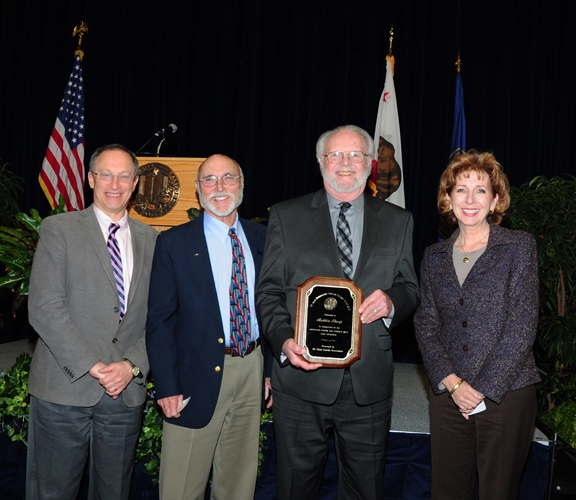



- Author: Kathy Keatley Garvey
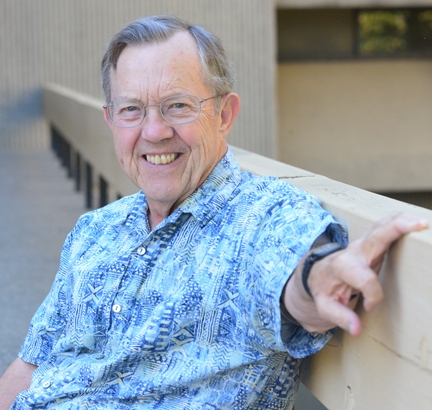
Dingle, a UC Davis emeritus professor of entomology and author of two editions of “Migration: The Biology of Life on the Move,” said his previous studies reveal that migrant and resident monarchs exhibit different wing shapes.
Dingle is the recipient of the UC Davis Edward A. Dickson Professorship Award to research “Monarchs in the Pacific: Is Contemporary Evolution Occurring on Isolated Islands?”
Dingle will be working with community ecologist Louie Yang and molecular geneticist Joanna Chiu, assistant professors in the UC Davis Department of Entomology and Nematology, to examine the ecology and physiology of monarch butterflies (Danaus plexippus) in three islands where contemporary evolution might be expected. The islands are Oahu (Hawaii), Guam (Marianas) and Weno (Chuuk or Truk).
“This is the necessary first step in a long-term analysis of the evolutionary ecology and physiology of monarch butterflies on remote Pacific islands,” said Dingle, a fellow of the American Association for the Advancement of Science and the Animal Behavior Society.
Dingle said the monarch, widely distributed “for eons” in the New World, is fairly new to the Pacific islands and to Australia. “In addition to North America, the monarch occurs as a resident throughout the Caribbean and Central and northern South America—and probably as a migrant farther south. One of the more intriguing aspects of its distribution is that beginning in the early part of the 19th century, it spread throughout the Pacific all the way to Australia, where there are now well-established migratory and non-migratory populations.”
Dingle speculates that the monarchs arrived in the Pacific islands with their host plant, milkweed, which was valued at the time for its medicinal properties. Some of the islands are extremely isolated, he said.
An analysis of a monarch population in Hawaii shows that resident monarchs have shorter, broader wings than the long-distance migrants. The Hawaii butterfly wings were shorter than the eastern U.S. long-distance migrants, but “not so short-winged as the residents in the Caribbean or Costa Rica, which have been present in those locations for eons, rather than the 200 years for Hawaii.”
“If there are indeed wing shape changes associated with evolution in isolation, are there other changes that may have occurred under selection and local adaptation for residency?” Dingle wonders. “Are there other changes that may have occurred under selection and local adaptation for residency? Examples of such traits might be changes in flight muscle physiology, changes in photoperiodic diapause response, changes in the characteristics of orientation ability and its relation to antennal circadian rhythms, or changes in the reproductive capacity or tactics (re-colonization of ‘empty' habitats is no longer part of the life cycle).
“Diapause and fat storage, necessary to support migration, are triggered by short photoperiods,” Dingle said, “and the butterflies orient using a sun compass synchronized to a circadian rhythm in the antennae. Overwintering sites in North America include the Transvolcanics Mountains of central Mexico, and the California Coast, particularly Santa Cruz, Pismo Beach, and Pacific Grove.
The UC Davis team will study the monarchs on the three islands and compare them with California mainland monarchs. Using an image analyzer and camera equipment available in Yang lab, the team will photograph “chilled” butterflies in a fixed position with wings spread and then release them back into the wild. The image analyzer will measure different variables, including length, width and angles from the photographs and compute multivariate-shape parameters.
The Chiu lab will assess genetic differences using a transcriptomic approach with monarch caterpillars. “This assessment will be greatly facilitated by the fact that the monarch genome has now been sequenced,” Dingle noted. “A major focus of Dr. Chiu's research is circadian rhythm genes, and these will be especially relevant here because of the association of these genes with monarch capabilities. Because the monarch cell line is cycling and has a functional circadian clock, effects of mutations in specific clock genes can be examined with regard to clock function.”
Dingle expects the one-year research program not only to form the basis for “long-term research on the evolutionary genetics of behavior, ecology and physiology on Pacific island monarch butterflies” but on “the general aspects of island biogeography, a subject of great practical theoretical interest in evolutionary biology.”
Both Yang and Chui currently have grants involving research on monarch butterflies. Yang also studies island ecology.
Dingle, who received his bachelor's degree in zoology from Cornell University and his doctorate in zoology from the University of Michigan, served on the faculty of the UC Davis Department of Entomology (now the UC Davis Department of Entomology and Nematology) from 1982 to 2002 and achieved emeritus status in 2003. He is a past president of the Animal Behavior Society and former secretary of the International Society for Behavioral Ecology.
Dingle published the second edition of “Migration: The Biology of Life on the Move” (Oxford University Press) in November 2014. It is the sequel to the widely acclaimed first edition, published in 1996. National Geographic featured Dingle in its cover story on “Great Migrations” in November 2010. LiveScience interviewed him for its November 2010 piece on “Why Do Animals Migrate?”
Dingle was interviewed recently by Italian journalist Giovanna Faggionato for a piece on migration in the Pirelli magazine.

- Author: Kathy Keatley Garvey

“Equally apparent are the migrations of insects like armyworm moths and locusts that have severe negative impacts on agricultural systems,” says Hugh Dingle, an emeritus professor of entomology at the University of California, Davis, and a worldwide authority on animal migration.
“What is not so appreciated, however, are the numerous tiny insects, mites, and spiderlings that also migrate.”
“Even to the most casual observer of nature it is apparent that migration is a conspicuous behavior for many organisms,” said Dingle, author of the newly published second edition of Migration: The Biology of Life on the Move (Oxford University Press), a sequel to the first edition published in 1996. “The great whales move up and down our coasts and are often viewable from promontories like Pt. Reyes; millions of birds appear in high latitudes to breed in the spring and depart in the fall; and millions of bright orange monarch butterflies inspire awe with their migrations from North America to overwintering sites in Mexico or on the coast of California.”
Winged aphids and ballooning spiders often escape the human eye. ““On summer evenings at temperate latitudes the air to considerable altitudes is often filled with winged aphids and ballooning spiders that with the aid of selected winds can migrate for hundreds or even thousands of kilometers,” he said. “Birds, grasshoppers, and moths are also adept at selecting winds of the right speed and direction, the more impressive because many of these migrations are at high altitude or at night when the ground cannot provide information on direction. Recent studies have shown that information may be derived from the kinetic energy of wind turbulence.”
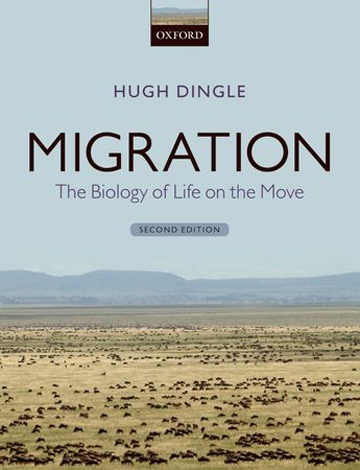
The book covers a wide taxonomic diversity of organisms from aphids to whales. Included is a discussion of recently developed techniques, such as radar and geolocators, used for tracking migrants. “These methods,” Dingle said, “reveal just how astonishing some migratory journeys can be; godwits and plovers, for example, make nonstop flights over the central Pacific Ocean from Alaska to Australia and New Zealand.”
However, not all migration is a round trip; sometimes it's one-way. “Important defining behavioral characteristics are specific departure and arrival tactics and the refusal to stop even in favorable habitats until the migration program is complete,” Dingle says. “In the words of National Geographic reporter David Quammen migrants ‘are flat-out just gonna get there.'
“The program or syndrome includes specific modifications of metabolic physiology like enhanced fat storage to fuel migration and of sensory systems to detect inputs from the sun, stars, and magnetic field lines to determine compass direction. Intimately involved in the latter are daily and yearly biological clocks. The pathway followed is an outcome of the syndrome of migratory behavior and is part of the ecology that provides the natural selection acting to determine the evolution of migration.”

“Natural selection acts differently on long versus short lives. With long lives there are usually many opportunities to produce offspring; with short lives there may be only one,” Dingle said. “Thus reproductive opportunities may determine when and where to migrate. Migrating aphids postpone reproduction until they colonize new host plants; birds reproduce following migration in the spring, but not in the fall. Some birds and insects use migration to exploit ‘rich patches' and breed in different places in different years or even in the same year.
There are also insects that alternate between winged generations for migration and colonization and wingless generations devoted exclusively to high reproductive effort once colonization is accomplished. Genes influence not only migratory effort but also the relation between behavior, reproduction, and morphological traits such as wing length (longer narrower wings in migrants).

“'They are flat-out just gonna get there,' as David Quammen said.”
National Geographic featured Dingle in its cover story on “Great Migrations” in November 2010. LiveScience interviewed him for its November 2010 piece on“Why Do Animals Migrate?”
Dingle, a fellow of the American Association for the Advancement of Science and the Animal Behavior Society, has done research throughout the world, including the UK, Kenya, Thailand, Panama, Germany and Australia.
He served as a professor at UC Davis Department of Entomology from 1982 to 2002, achieving emeritus status in 2003. He chaired the Animal Behavior Graduate Group from 1985 to 1988; and was acting director of the Animal Behavior Center, 2000-2002.
Dingle is a former secretary of the International Society for Behavioral Ecology and past president of the Animal Behavior Society.

- Author: Kathy Keatley Garvey

Fox, a leading evolutionary ecologist, specializes in insect genetiics and behavior and evolutionary ecology. Host is Professor Jay Rosenheim of the UC Davis Department of Entomology and Nematology.
One of Fox's research subjects is a beetle, Callosobruchus maculatus, commonly known as the cowpea weevil or cowpea seed beetle. A member of the leaf beetle family, Chrysomelidae, it is a common pest of stored legumes. The beetle is found every continent except Antaractica.
Fox received his bachelor's degree in zoology in 1987 from UC Davis, and his doctorate in 1993 from UC Berkeley through the Department of Integrative Biology. While in graduate school, he worked at UC Davis for three years (1991-1993) with Hugh Dingle, now emeritus professor of entomology.
Fox joined the University of Kentucky's entomology faculty in 1999. Previously he worked at Fordham University, New York, his first faculty position (1996-1999).
He completed postdoctoral research at the Department of Biological Sciences, University of South Carolina (1993-1996), working in the laboratory of Timothy Mousseau.
Fox lists his research interests as:
- Ecology and Evolution of Life Histories
- Body Size, Sexual Size Dimorphism
- Egg Size
- Phenotypic Plasticity
- Aging and Senescence
- Maternal Effects
- Inbreeding Depression
- Insect-Plant Interactions
- Diet Evolution
Adaptation to Host Plants - Insect Behavioral Ecology
- Egg Laying Decisions
- Sexual Selection on Body Size / Sexual Dimorphism
Some of his recently published papers on inbreeding depression:
Reed, David H.; Fox, Charles W.; Enders, Laramy S.; et al. 2012. Inbreeding-stress interactions: evolutionary and conservation consequences. Year in Evolutionary Biology, Book Series: Annals of the New York Academy of Sciences 1256:33-48.
Fox, C. W.; Xu, J.; Wallin, W. G.; et al. 2012. Male inbreeding status affects female fitness in a seed-feeding beetle. Journal of Evolutionary Biology 25:29-37.
Fox, Charles W.; Reed, David H. 2011. Inbreeding depression increases with environmental stress: an experimental study and meta-analysis. Evolution 65:246-258.
Fox, Charles W.; Stillwell, R. Craig; Wallin, William G.; et al. 2011. Inbreeding-environment interactions for fitness: complex relationships between inbreeding depression and temperature stress in a seed-feeding beetle. Evolutionary Ecology 25:25-43.
His seminar will be recorded for later viewing on UCTV.
Upcoming seminars:
Wednesday, Nov. 12
Louie Yang
Assistant professor, UC Davis Department of Entomology and Nematology, specializing in ecology
Title: "Pulses, Phenology and Ontogeny: Towards a More Temporally Explicit Framework for Understanding Species Interactions?"
Wednesday, Nov. 19
Ray Hong
Associate professor of biology, California State University, Northridge, specializing in nematology
Title: “A Fatal Attraction: Regulation of Development and Behavior in the Nematode Pristionchus pacificus by a Beetle Pheromone”
Host: Valerie Williamson, professor of nematology, Department of Entomology and Nematology
Wednesday, Nov. 26
Doris Bachtrog, lab
Associate professor of integrative biology, UC Berkeley, specializing in evolutionary and functional genomics
Title: "Numerous Transitions of Sex Chromosomes in Diptera"
Host: Michael Parrella, professor and chair, Department of Entomology and Nematology
Wednesday, Dec. 3
To be announced
Wednesday, Dec. 10
Sawyer Fuller
Postdoctoral researcher, Harvard University
Title: "RoboBee: Using the Engineering Toolbox to Understand the Flight Apparatus of Flying Insects"
Host: James Carey, distinguished professor of entomology
This seminar is being remote broadcast to UC Davis via internet
Plans call for recording the seminars, coordinated by Professor James Carey, for later posting on the web.


